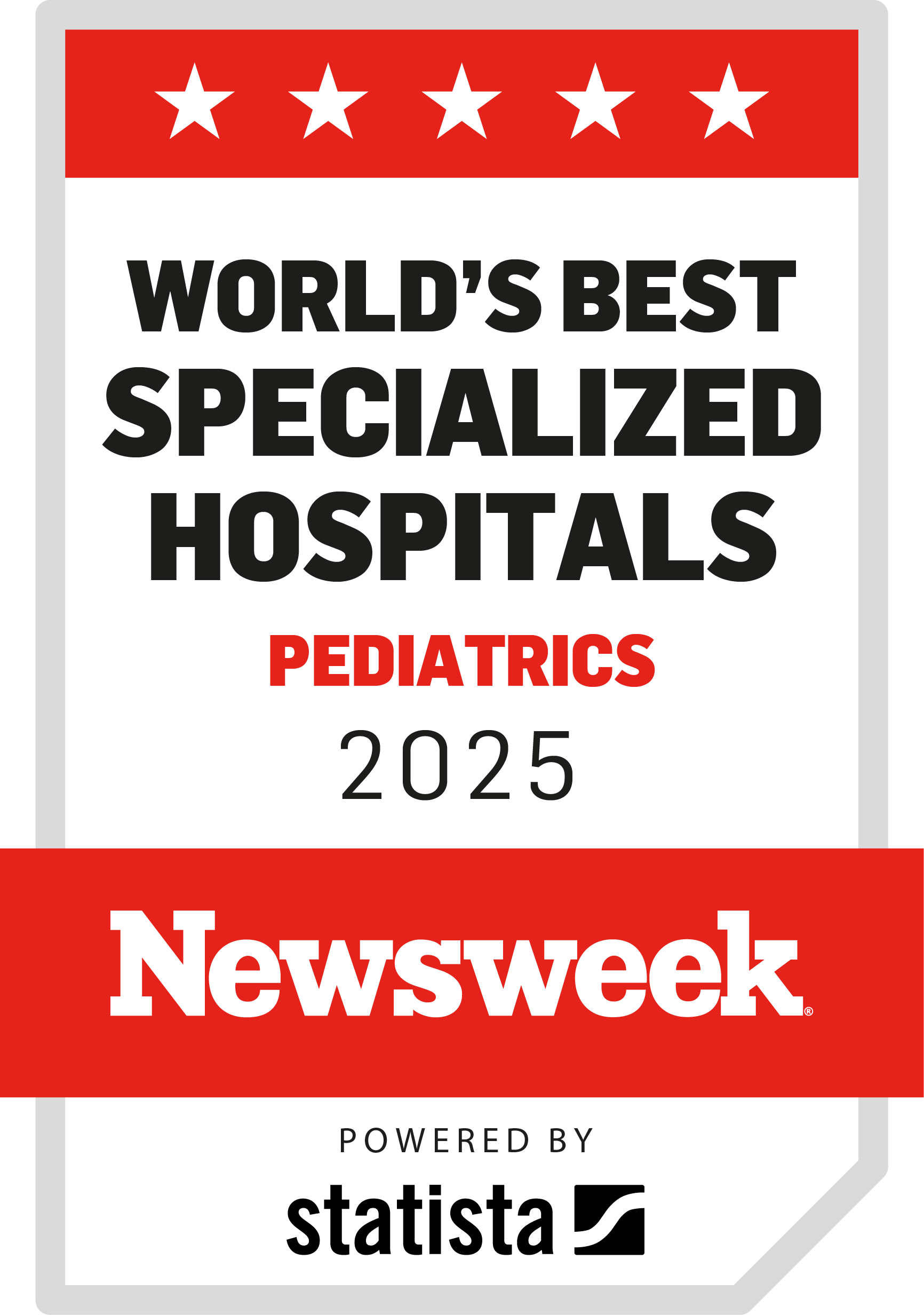Vascular Ring | Symptoms & Causes
What are the symptoms of a vascular ring?
Vascular rings are caused by malformed blood vessels. But the vessels themselves aren’t really the issue, and some people without symptoms may live their entire lives not even realizing that they have a vascular ring. Instead, symptoms occur when a vascular ring puts pressure on a child’s esophagus, trachea, or both. Symptoms range widely depending on the severity of the compression and can include:
- Stridor (noisy breathing)
- Wheezing or cough
- Respiratory distress
- Difficulty eating when introduced to solid foods
- Swallowing difficulties (dysphagia)
- Gastroesophageal reflux (GERD)
- Frequent or prolonged respiratory infections
Children with vascular rings often also have an airway disorder called tracheomalacia. With this condition, the trachea narrows or collapses when a child exhales, which makes it feel hard to breathe and may lead to a vibrating noise or cough. Tracheomalacia can be present at birth, or it can develop in response to vascular ring or other anomalies.
What causes a vascular ring?
Normally, the aorta develops from one in a series of symmetrical arches. By the end of the second month of fetal development, the other arches are naturally broken down or formed into arteries. When a vascular ring occurs, certain arches that should have disappeared still remain and form a ring structure.
Vascular Ring | Diagnosis & Treatments
How is a vascular ring diagnosed?
Some children are diagnosed before birth by fetal ultrasounds and fetal echocardiograms. Other children may be diagnosed based on symptoms that are concerning for a vascular ring leading to imaging that will help confirm the suspected vascular ring diagnosis. Your child’s provider may order one or more of the following tests to help diagnose this condition:
- X-ray
- Echocardiogram (cardiac ultrasound)
- Esophagram
- Magnetic resonance imaging (MRI) with contrast
- Computed tomography (CT) scan with contrast
The gold standard for evaluating and identifying vascular rings is a computed tomography (CT) chest angiogram. This technique allows physicians to properly visualize your child’s vascular anatomy. Vascular rings can be diagnosed at any age, including while a child is still in the womb.
How Boston Children’s cares for vascular rings
The clinicians at Boston Children’s Vascular Ring and Airway Program and the Esophageal and Airway Treatment Center work together to provide collaborative care and, when necessary, surgery for children with vascular rings and airway or esophageal compression. Our depth and breadth of experience also allows us to revise incomplete or failed repairs performed elsewhere with recurrence of airway or esophageal symptoms.
What are the treatment options for a vascular ring?
Here are some of the proven, cutting-edge surgical techniques our specialists use to treat vascular rings.
- Complete resection of the diverticulum of Kommerell; if this structure is not fully resected, it can remain as a source of compression and lead to recurrent symptoms.
- Descending aortopexy, which moves the descending aorta to the side of the spine so that it doesn’t compress the airway or esophagus.
- Rotational esophagoplasty, which moves the esophagus out of the way typically to allow for a posterior tracheopexy.
- Posterior tracheobronchopexy, which keeps the airways open in patients with persistent tracheobronchomalacia despite removing the compressing structures. Occasionally, these children will also need anterior airway support to completely open the airways.
- Aortic arch reconstruction including aortic uncrossing or translocation, which are techniques to reroute the aorta and can be combined with other airway and esophageal procedures
Boston Children’s is one of the few hospitals to repair vascular rings with a combination of these procedures in one comprehensive surgical procedure. Treating a child with just one operation ensures that the condition is treated thoroughly and prevents the need for future procedures. Our depth and breadth of experience also allows us to revise incomplete or failed repairs performed elsewhere with recurrence of airway or esophageal symptoms.
Common vascular ring diagnoses and the surgeries we perform
Our surgical approach involves addressing the vascular ring itself as well as assessing the need for additional airway or esophageal interventions to ensure a durable repair. We consider additional approaches in cases where a patient may have compression from not only the vascular ring, but also at other levels that is attributed to other structures. For example, the location of the aorta may lead to compression and may be indicated for repair as well. Each of these approaches are detailed here:
Left aortic arch with aberrant right subclavian artery repair
Although it is not shaped like a “true” vascular ring, we consider the anatomy of this condition to be an incomplete vascular ring. It may require treatment based on whether symptoms are similar to a true vascular ring. The aortic arch is left-sided, and the right subclavian artery typically passes behind the airway (breathing tube) and esophagus (swallowing tube). The aberrant right subclavian artery can compress the esophagus, causing a “speed bump” for liquids and solids during swallowing. Individuals with vascular rings can also have a condition called tracheomalacia, which is a collapse of the airway when breathing.
The typical surgical approach involves a right thoracotomy and relocation of the aberrant right subclavian artery (Ab RSCA) to the right common carotid artery (RCCA).
Right aortic arch with an aberrant left subclavian artery repair
A right aortic arch with aberrant left subclavian artery and left ligamentum is a type of complete vascular ring. The aortic arch is right-sided, and the left subclavian artery is connected to the aorta by the diverticulum of Kommerell (which is an outpouching at the origin of the aberrant left subclavian artery). The diverticulum of Kommerell is frequently large and a source of compression to the airway and esophagus. The ligamentum connects the aorta to the pulmonary trunk to form a “napkin ring” around the trachea (breathing tube) and esophagus (swallowing tube). Individuals with vascular rings can also have a condition called tracheomalacia, which is a collapse of the airway when breathing.
The typical surgical approach involves a left thoracotomy and relocation of the aberrant left subclavian artery (Ab LSCA) to the left common carotid artery (LCCA).
Double aortic arch repair
A double aortic arch is a type of complete vascular ring. The aortic arch is two-sided instead of one-sided. The aortic arch is made up of a right aortic arch and a left aortic arch. The ligamentum arteriosum connects the aorta to the pulmonary trunk. Typically, the presence of both arches and the ligamentum forms a napkin ring around the trachea (breathing tube) and esophagus (swallowing tube). The “napkin” ring can compress or squeeze the trachea or esophagus, or both, causing swallowing or breathing problems. Individuals with vascular rings can also have a condition called tracheomalacia, which is a collapse of the airway when breathing.
Typically, surgery involves a thoracotomy and removal of smaller aortic arch.
Other less common types of vascular rings
We also treat other types of vascular rings, including a right aortic arch with mirror-image branching and left ligamentum arteriosum, anomalous left pulmonary artery, double aortic arch associated with coarctation of aorta, and circumflex aorta.
Additional vascular interventions
In addition to the vascular ring repairs above, we also have experience with several other procedures to address additional sources of compression beyond the vascular ring itself. These surgical approaches are pursued when the patient has substantial compression from the vascular ring itself and other structures, such as a circumflex aorta.
- Descending aortic translocation: This operation reconstructs the aortic arch in patients with tracheobronchial compression caused by the aorta being slung over the airway.
- Aortic elongation: This procedure lengthens either the ascending or descending aorta to relieve compression caused by an aorta that is too short.
- Aortic uncrossing: To relieve swallowing difficulties, this operation reroutes the aorta in patients who have a circumflex aorta, which describes a phenomenon where the descending aorta crosses from one side to the other behind the airway and/or esophagus. This can result in additional compression to those structures.
- Aortopexy: This operation moves the aorta out of the way from where it may be causing compression of either the airway or esophagus.
- Pulmonary artery sling repair: The pulmonary artery arises from an abnormal location leading it to loop around the airway and esophagus. We can repair this by relocating the pulmonary artery to avoid this compression.
Airway interventions
Some patients may have an airway evaluation prior to surgery or during the operation itself. During each surgery, we carefully evaluate the airway for residual airway compression that may need to be addressed with additional airway interventions, as detailed here:
- Tracheopexy: This procedure provides additional support to the airway by suspending either the front or back wall of the airway.
- Resorbable airway splint: If a tracheopexy alone does not sufficiently support the airway, a tracheobronchial splint can hold open a patient’s airway without being placed inside the airway. The device will be naturally absorbed by the body over time.
- Slide tracheoplasty: This procedure is indicated in patients who present with complete tracheal rings and involves removing the area of the airway with complete tracheal rings.
Esophageal interventions
To ensure a complete repair, we will assess the need for esophageal interventions to ensure sources of compression are addressed.
- Esophageal mobilization: This removes adhesions or any scar tissue around the esophagus and moves it away from structures that are causing compression.
- Rotational esophagoplasty: For some types of tracheopexies, the esophagus is “rotated” to one side of the chest to allow room for the trachea to be suspended to the back of the spine, as opposed to just mobilizing the esophagus and not performing a tracheopexy.
Reoperations
If a patient’s surgery did not address the vascular ring completely, they may have recurrent symptoms and require another operation. For example, with a right aortic arch with an aberrant left subclavian artery, if the ligamentum was only divided, the patient may need a reoperation to address the ring completely, such as with subclavian relocation. Similarly, if the subclavian had been relocated, but the diverticulum was not fully resected, the patient may require reoperation to fully address the diverticulum.
Sternal reconstructions
We are one of the few hospitals in the world that offers sternal reconstruction to relieve crowding between a patient’s sternum and spine, which can result in compression of various structures in the chest, such as the airway, esophagus, and vascular structures. The surgery is performed by a multidisciplinary team that includes a cardiac surgeon, general surgeon, orthopedic surgeon, and plastic surgeon. We also frequently work with the Cardiovascular 3D Modeling and Simulation Program to support surgical planning and visualization of each patient’s anatomy.


